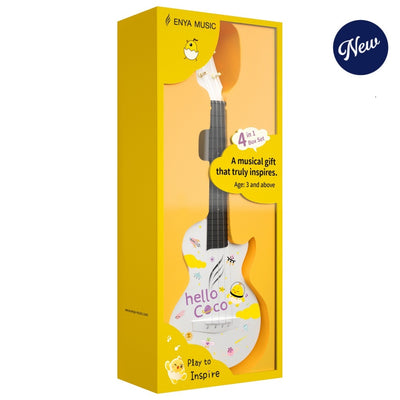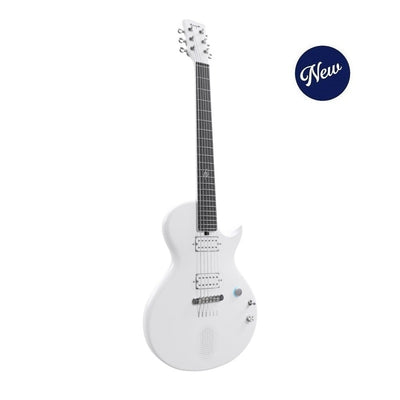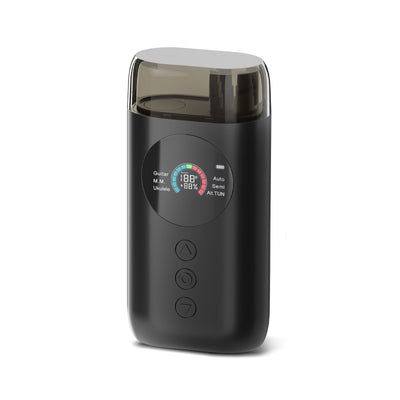Alternative Chord Shapes on the Ukulele

In addition to its infectiously happy tone, much of the appeal of playing the ukulele lies in its simplicity. Its basic chord shapes allow new players to start playing songs in minutes. However, underneath the surface of simple chords and happy tunes lies a vast musical world that every ukulele player can benefit from exploring. Let’s crack into that world by taking a look at alternative chord shapes.
WHAT IS AN ALTERNATIVE CHORD SHAPE?
An alternative chord shape is simply a second fingering that can be used to play a chord. For example, here’s C major in its basic position:

And here’s another way to play to C major:

If you play one after the other, you’ll notice that despite being made up of the same notes, the varying positions give them each a slightly different sound — the second chord sounds brighter and lighter, while the first sounds fuller and warmer.
In reality, there are many different ways you can play a C major chord on the ukulele. Here are 10 of them:
The same goes for all chords — for every ukulele chord, there are tons of alternative fingerings that can be used to play it. Learning and practicing these alternative shapes expands the range of what you are capable of playing. A lot of times, we get stuck playing at the lower end of the fretboard, almost as if all of the frets above the fourth one don’t exist. While there’s nothing wrong with this style of playing, learning to utilize the entire fretboard will make you a more well-rounded player.
RESOURCES FOR LEARNING ALTERNATIVE CHORD SHAPES
CHORD LIBRARIES
There are a bunch of online chord libraries that you can use to learn new chord shapes. That being said, if you own an Enya instrument, you have free access to one of the most in-depth chord libraries out there within their “OKMusician” app. It allows you to select any chord by choosing a musical note and a chord type (major, minor, seventh, etc.), and then shows you every possible fingering for that chord. Fingerings are organized by difficulty so that you can easily find one that works for you. In addition to a chord diagram for each, there is an animated fretboard that shows you how your fingers should be positioned. Plus, when you select a fingering, the app plays that chord so you can hear how it should sound. All of these features make for a helpful all-in-one resource for learning new chords, and an excellent tool for experimenting with alternative chord shapes.
THE “SHAPE-SLIDING” TECHNIQUE
Another trick to help you find different chord fingerings is to take a basic chord and move its shape up and down the fretboard. For example, let’s say you start with an E minor chord in its basic position:

Keeping your fingers locked in that shape, move the whole chord up one fret.

Strum the bottom three strings. This is now an F minor chord, since we moved up one fret (or one semitone, in music theory terms), and F is one semitone above E. Move up another fret and you have F#m, and then Gm, G#m, and so on. It’s helpful to know the chromatic scale (the basic scale made up of all twelve notes used in western music) in order to use this trick. Starting on C, it goes:
C C# D D# E F G G# A A# B (C)
The important things to remember are that each note is one fret away from the next, and that E and B are the only notes that do not have sharps.
So, let’s say you are looking for a different way to play a B chord. Since B is four semitones above G, you could take a G chord and shift it up four frets. Or you could take an F chord and shift it up six frets. This is a quick and easy method for finding alternative chord shapes.
BAR CHORDS
I mentioned that when shifting the E minor chord shape up the fretboard, you should only strum the bottom three strings. This is because the G string would remain open and play a note that’s not in the next chord. You’ll run into this problem with a lot of basic chord shapes, since most of them use open strings. In order to get around it, you can use bar chords. These are chords where you use one finger to hold down multiple strings on a single fret.
For example, let’s look at the F major chord shape. Note that the C and A strings are both open.

If we moved that shape up one fret, the open strings would create notes that are not in the new chord (F# major). Instead, we want the open strings to shift up to the first fret. To do this, bar the bottom three strings on the first fret with your index finger, place your ring finger on fret three of the G string, and place your middle finger on fret two of the E string.

Now you have an F# major chord with all the correct notes, and a chord shape that you can shift up the fretboard without having to worry about strumming a note that’s not in the chord. This technique works for shifting any chord shape that has open notes in it.
Learning to play bar chords will take some time. One tip for practicing them is to fret the chord and then pluck each string one at a time to see if any are buzzing or muted. This will allow you to see if and how you need to adjust your fretting hand. Other than that, persistence and patience are the keys to getting them down.
A lot of times when we are playing a cover, basic ukulele chords don’t sound quite like the ones in the original song. However, by moving them around on the fretboard, you may find a chord voicing that does sound closer to the original. Alternative chord shapes will add a ton of variety to your ukulele playing, helping keep your experience fresh and exciting while making you a better player. Go try some out!









